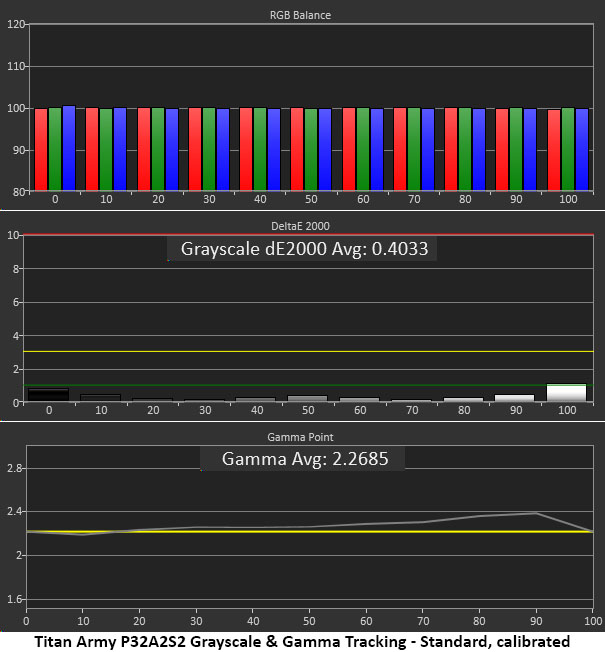Why you can trust Tom's Hardware
The P32A2S2 has ten picture modes but you’ll truly only need Standard for everything, be it games or productivity. It’s reasonable out of the box, but calibration is a simple matter that takes the image to near reference-level.
Grayscale and Gamma Tracking
Our grayscale and gamma tests use Calman calibration software from Portrait Displays. We describe our grayscale and gamma tests in detail here.


A grayscale step pattern shows the P32A2S2’s red tint. It’s visible from the 20% brightness step and increases as you go up. This is a forgivable error because it doesn’t greatly impact image quality. Blue and green errors are more detrimental. Gamma tracks close to the 2.2 reference with a slight rise (too dark) at 70-90% brightness.
Calibration removes all visible grayscale errors and returns a pro-level result. Gamma becomes slightly darker at the top of the brightness range, but this does not negatively impact image quality. This is excellent performance.
Comparisons




The P32A2S2’s default grayscale error of 5.86dE is all due to its red tone. While that number is a bit high, the red error isn’t as grievous as a blue or green one would be. After calibration, the P32A2S2 zips to the top with a superb 0.40dE score. It doesn’t get much better than that.
The range of gamma values is reasonably tight at 0.20 from lowest to highest. That’s an average result. The actual value of 2.27 is a 3.18% deviation from the 2.2 standard. Again, this is a better outcome than if gamma were too low. A slightly dark tone can be compensated for by increasing the brightness control. But a light tone will always look washed out.
Color Gamut Accuracy
Our color gamut and volume testing use Portrait Displays’ Calman software. For details on our color gamut testing and volume calculations, click here.
Get Tom's Hardware's best news and in-depth reviews, straight to your inbox.


The P32A2S2 starts from a good place in the color gamut test. Red and blue are a touch over-saturated while green is a tad under. These are minor errors that are nearly invisible to the naked eye when viewing actual content. Magenta and yellow are a bit off-hue as well.
Calibration brings everything neatly into line with a visually perfect result. Like the grayscale test, this is a superb gamut chart with every point on target except for a slight over-saturation in the blue primary. My only complaint is that there is no sRGB mode available here.
Comparisons


The P32A2S2’s 1.54dE gamut score is excellent by any measure and good enough for third place in this tight group of displays. It’s a nod to today’s gaming monitor quality when six screens measure so closely. To the naked eye, there is no significant difference.
In the volume test, the P32A2S2 is again mid-pack, but its 93.18% coverage of DCI-P3 is above average. You’ll see a bit less green when looking at the Omen 27qs or the CQ27G3Z. The top three monitors have just a little more red in their palettes. The 138% score for sRGB means the P32A2S2 has no sRGB preset. If you need that gamut, you’ll have to look at a different monitor. However, for critical work in the DCI-P3 space, it is qualified.
Test Takeaway: The P32A2S2 is a 32-inch QHD 240 Hz screen for $370 so it’s already a great value. That it is capable of very accurate and very saturated color is a nice bonus. Calibration is recommended, but all you need to do is lower the red slider one click and you’re there. With decent gamma and satisfying color volume, it delivers an excellent picture well suited for work or play. My only complaint is that there’s no sRGB mode.
MORE: Best Gaming Monitors
MORE: How We Test PC Monitors
MORE: How to Buy a PC Monitor
MORE: How to Choose the Best HDR Monitor
Current page: Grayscale, Gamma and Color
Prev Page Brightness and Contrast Next Page HDR Performance
Christian Eberle is a Contributing Editor for Tom's Hardware US. He's a veteran reviewer of A/V equipment, specializing in monitors. Christian began his obsession with tech when he built his first PC in 1991, a 286 running DOS 3.0 at a blazing 12MHz. In 2006, he undertook training from the Imaging Science Foundation in video calibration and testing and thus started a passion for precise imaging that persists to this day. He is also a professional musician with a degree from the New England Conservatory as a classical bassoonist which he used to good effect as a performer with the West Point Army Band from 1987 to 2013. He enjoys watching movies and listening to high-end audio in his custom-built home theater and can be seen riding trails near his home on a race-ready ICE VTX recumbent trike. Christian enjoys the endless summer in Florida where he lives with his wife and Chihuahua and plays with orchestras around the state.
-
das_stig Stop saying "No internal speakers or USB ports" is a con, to some people it's a plus, it's all personal taste and not just a bias reporter !Reply -
kyzarvs Reply
Exactly - why pay for speakers that are never going to be used?das_stig said:Stop saying "No internal speakers or USB ports" is a con, to some people it's a plus, it's all personal taste and not just a bias reporter ! -
Pirx73 Reply
Well, USB ports on monitor could be useful, while internal speakers - absolutely agree with you, they are useless. They are just one step above old PC beeper. Sound quality is nonexistant. I don't know why they keep including them, if only to rise price.das_stig said:Stop saying "No internal speakers or USB ports" is a con, to some people it's a plus, it's all personal taste and not just a bias reporter !
